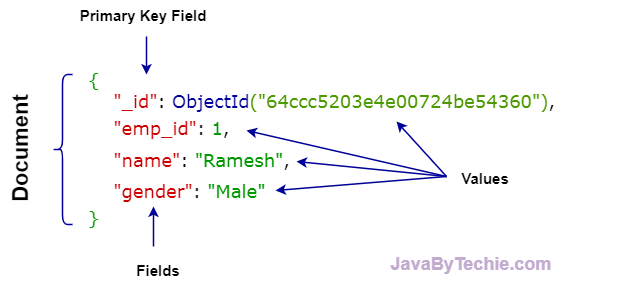MongoDB Introduction
Last Updated: 04 October, 2023
MongoDB is an open-source, NoSQL (non-relational), cross-platform, document-oriented database that provides powerful features such as high performance, high availability, and easy scalability. MongoDB is platform-independent and runs in the same way on all platforms, whether it is Windows, Linux, Mac OS, etc.
MongoDB works on the concepts of collection and document.
Collections contain a group of documents and functions, which is the equivalent of a relational database table.
MongoDB uses JSON or BSON documents to store data in the form of key-value pairs, which is the equivalent of a relational database table row.
The following is an example of a JSON-based document.

Here are some of the key features of MongoDB:
- Document-Oriented: MongoDB stores data in flexible, JSON-like documents called BSON (Binary JSON), which can have varying structures and schemas. This flexibility allows developers to easily work with evolving and complex data.
- Scalability: MongoDB is designed to scale horizontally, meaning it can handle increased traffic and data by distributing the load across multiple servers or clusters. It offers automatic sharding, which partitions data across different machines, and replication, which ensures high availability and data redundancy.
- High Performance: MongoDB provides high-speed read and write operations by utilizing in-memory computing and other optimization techniques. It supports various indexing options, allowing efficient querying of data.
- Rich Query Language: MongoDB's query language supports a wide range of queries, including field queries, range queries, regex queries, and geospatial queries. It also supports aggregation pipelines, which enable complex data transformations and analysis.
- Flexible Data Model: MongoDB allows dynamic schema design, allowing documents within a collection to have different fields and structures. This flexibility enables faster development and accommodates changes in application requirements.
- Replication and Fault Tolerance: MongoDB offers replica sets, which are self-healing clusters of database nodes. Replica sets provide data redundancy and automatic failover, ensuring high availability and data reliability.
MongoDB is widely used in various industries and applications, including web applications, content management systems, real-time analytics, social networks, and IoT (Internet of Things) applications. Its ease of use, scalability, and flexibility make it a popular choice for modern application development.
That's all, guys. I hope this MongoDB article is helpful for you.
Happy Learning... 😀
Please share this article on social media to help others.
feedback@javabytechie.com
Currently No Video available


